Primark in Asia: Strategic Supply Chain for Product Sourcing
VerifiedAdded on 2023/06/05

SUPPLY CHAIN MANAGEMENT
SUPPLY CHAIN STRATEGY FOR PRIMARK FOR SOURCING ITS PRODUCTS IN ASIA
STUDENT NAME
INSTITUTIONAL AFFILIATION(S)
Paraphrase This Document

1. Introduction....................................................................................................................2
2. Review of Literature..............................................................................................................3
3. Industry overview...................................................................................................................4
4. Current trend and market segmentation of Asian apparel industry........................................5
5. SCM and buyer-seller relationship in clothes industry..........................................................7
6. Supply chain strategy for sourcing Primark products in Asia................................................8
6.1. Characteristics of clothes market.....................................................................................8
6.2. Basic supply chain followed by clothes companies........................................................9
6.3. Agile supply chain (AGC) framework..........................................................................11
6.4. Implementing ASC in Primark core business strategy..................................................13
7. Conclusion............................................................................................................................15
References................................................................................................................................17

In today’s marketplace, the strong competition has not only made companies develop
a link between networking partners but also develop enhance supply chain systems for
smooth functioning of businesses in local and foreign countries. Consumers demand also
keep changing for which companies need to react promptly whenever a new trend and
customers’ needs appear, henceforth making competition more time-sensitive. It can be said
that fashion apparel industry is more prone to such changes that can contribute in determining
failure or success of brands (Kumar, 2005).
Unlike other sectors, clothing industry has also been witnessing global recession,
however, Primark has been able to sustain present sluggish market by showing a remarkable
growth with opening more than 200 stores with refurbished supply chain management in the
company. Ethical trading in supply chain of the company is one of the many reasons for such
growth, however, there are few stances when the company was criticised for working with
suppliers involved in unethical practices in their manufacturing units (BusinessGreen, 2018).
Nevertheless, the main purpose behind this report is to identify significant factors that needs
to be considered for developing a successful supply chain strategy for sourcing Primark’s
clothes to retailers situated in Asian market.
Primark is one of the apparel companies that has developed its efficient supply chain
in European retail market. Presently, Primark sources its products in several countries namely
Spain, Germany, UK, Portugal, Belgium, Ireland and Netherland. Primark’s targeted
consumers are mainly fashion oriented people who values for money. Primark is able to offer
value intensive products by sourcing its products in efficient manner focussing upon market
size, volume, and country’s economic stability. Primark is also focused to expand its business
while meeting its customers’ demands (Primark, 2010).
⊘ This is a preview!⊘
Do you want full access?
Subscribe today to unlock all pages.

Trusted by 1+ million students worldwide
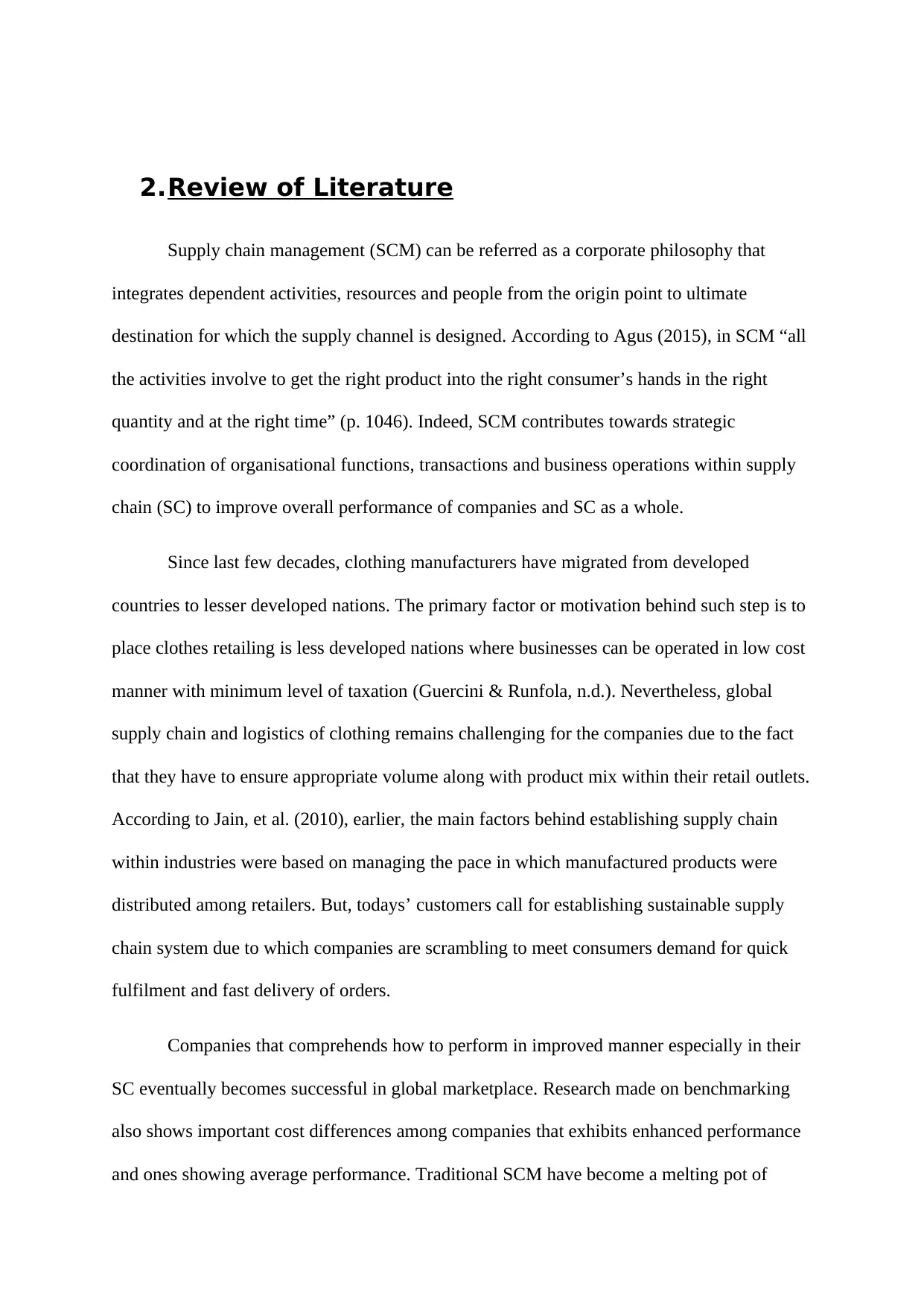
Supply chain management (SCM) can be referred as a corporate philosophy that
integrates dependent activities, resources and people from the origin point to ultimate
destination for which the supply channel is designed. According to Agus (2015), in SCM “all
the activities involve to get the right product into the right consumer’s hands in the right
quantity and at the right time” (p. 1046). Indeed, SCM contributes towards strategic
coordination of organisational functions, transactions and business operations within supply
chain (SC) to improve overall performance of companies and SC as a whole.
Since last few decades, clothing manufacturers have migrated from developed
countries to lesser developed nations. The primary factor or motivation behind such step is to
place clothes retailing is less developed nations where businesses can be operated in low cost
manner with minimum level of taxation (Guercini & Runfola, n.d.). Nevertheless, global
supply chain and logistics of clothing remains challenging for the companies due to the fact
that they have to ensure appropriate volume along with product mix within their retail outlets.
According to Jain, et al. (2010), earlier, the main factors behind establishing supply chain
within industries were based on managing the pace in which manufactured products were
distributed among retailers. But, todays’ customers call for establishing sustainable supply
chain system due to which companies are scrambling to meet consumers demand for quick
fulfilment and fast delivery of orders.
Companies that comprehends how to perform in improved manner especially in their
SC eventually becomes successful in global marketplace. Research made on benchmarking
also shows important cost differences among companies that exhibits enhanced performance
and ones showing average performance. Traditional SCM have become a melting pot of
Paraphrase This Document
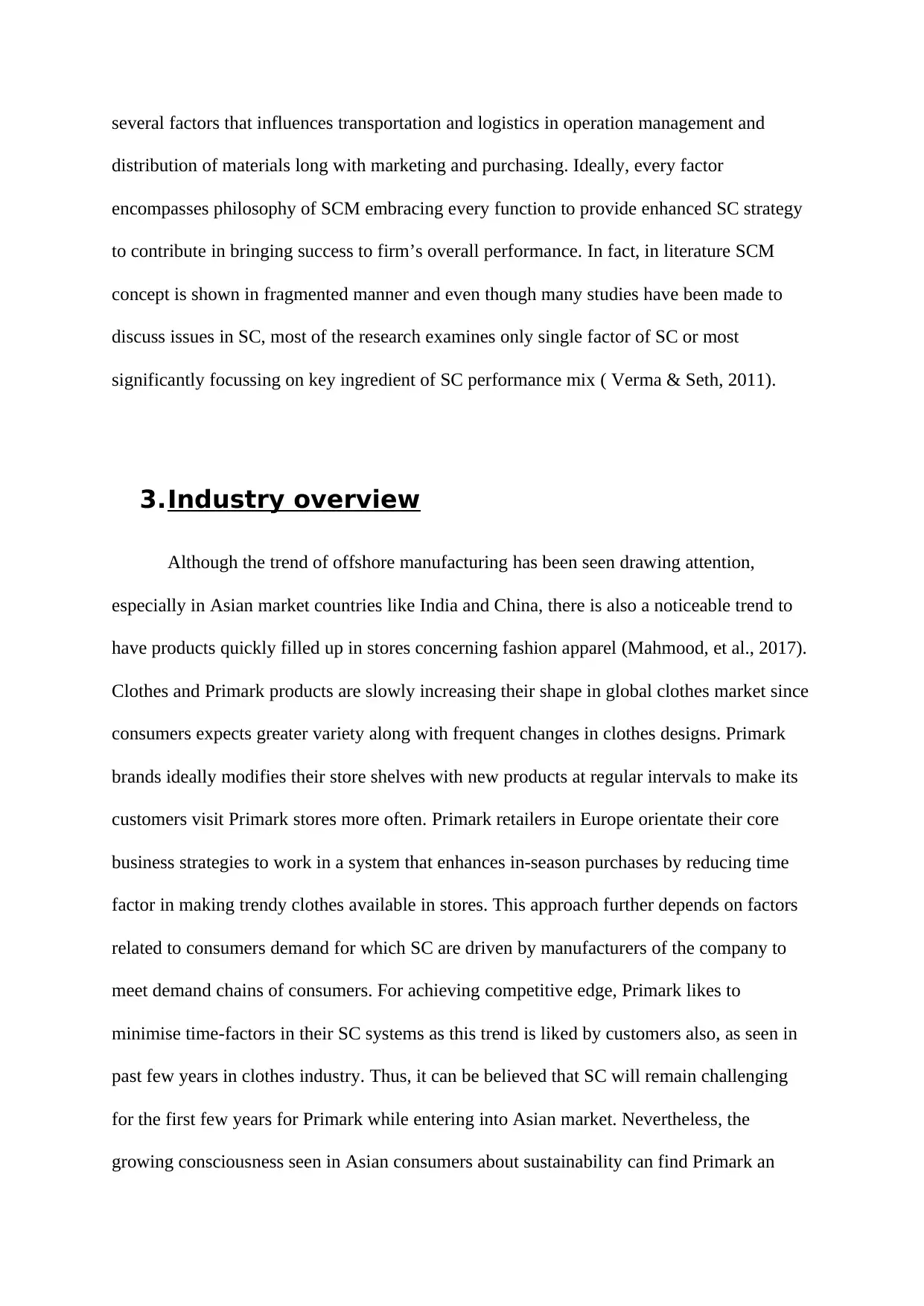
distribution of materials long with marketing and purchasing. Ideally, every factor
encompasses philosophy of SCM embracing every function to provide enhanced SC strategy
to contribute in bringing success to firm’s overall performance. In fact, in literature SCM
concept is shown in fragmented manner and even though many studies have been made to
discuss issues in SC, most of the research examines only single factor of SC or most
significantly focussing on key ingredient of SC performance mix ( Verma & Seth, 2011).
3.Industry overview
Although the trend of offshore manufacturing has been seen drawing attention,
especially in Asian market countries like India and China, there is also a noticeable trend to
have products quickly filled up in stores concerning fashion apparel (Mahmood, et al., 2017).
Clothes and Primark products are slowly increasing their shape in global clothes market since
consumers expects greater variety along with frequent changes in clothes designs. Primark
brands ideally modifies their store shelves with new products at regular intervals to make its
customers visit Primark stores more often. Primark retailers in Europe orientate their core
business strategies to work in a system that enhances in-season purchases by reducing time
factor in making trendy clothes available in stores. This approach further depends on factors
related to consumers demand for which SC are driven by manufacturers of the company to
meet demand chains of consumers. For achieving competitive edge, Primark likes to
minimise time-factors in their SC systems as this trend is liked by customers also, as seen in
past few years in clothes industry. Thus, it can be believed that SC will remain challenging
for the first few years for Primark while entering into Asian market. Nevertheless, the
growing consciousness seen in Asian consumers about sustainability can find Primark an
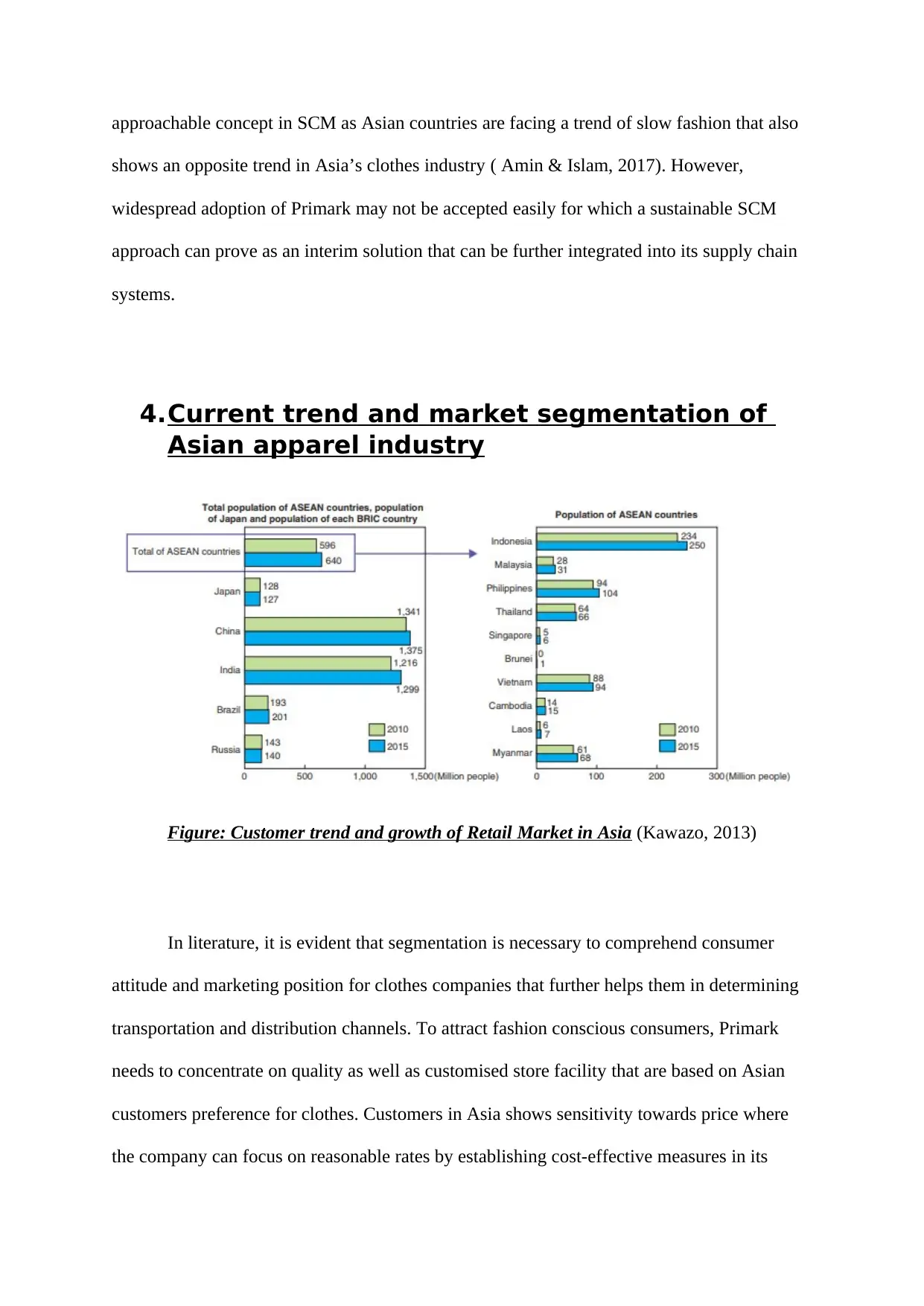
shows an opposite trend in Asia’s clothes industry ( Amin & Islam, 2017). However,
widespread adoption of Primark may not be accepted easily for which a sustainable SCM
approach can prove as an interim solution that can be further integrated into its supply chain
systems.
4.Current trend and market segmentation of
Asian apparel industry
Figure: Customer trend and growth of Retail Market in Asia (Kawazo, 2013)
In literature, it is evident that segmentation is necessary to comprehend consumer
attitude and marketing position for clothes companies that further helps them in determining
transportation and distribution channels. To attract fashion conscious consumers, Primark
needs to concentrate on quality as well as customised store facility that are based on Asian
customers preference for clothes. Customers in Asia shows sensitivity towards price where
the company can focus on reasonable rates by establishing cost-effective measures in its
⊘ This is a preview!⊘
Do you want full access?
Subscribe today to unlock all pages.

Trusted by 1+ million students worldwide

present in Asian market that are able to deliver high range of clothes in retail counters who
further exports them in international market. Besides, retail stores owners are also
establishing associations with flourished industries that provides Primark with great scope in
making relationship with present retail store owners. However, to build a strong marketing
strategy, detailed exploration of clothes industry in Asian market can be made further that can
influence Primark’s leaders in developing marketing related strategies.
Source: (McKinsey & Company , 2018)
Current trend in Asian market shows that clothes industry over there are moving
forward in critical way due to digital adaptation by consumers and online purchasing
behaviour especially in apparel and footwear. According to a recent survey made, it was
found that consumers in Southeast Asian regions spend around 8 hours online every day from
social media screening to making online purchases. However, regardless of the emerging
trend, customers expect a consistent brand exposure every time. One reason behind growth of
such concern is consumers desire to remain engaged with their preferred brand and avoid
duplicitous products available in online stores. Since present customers demand authenticity
in their preferred brand, they end up choosing those brands which they can touch and feel
Paraphrase This Document
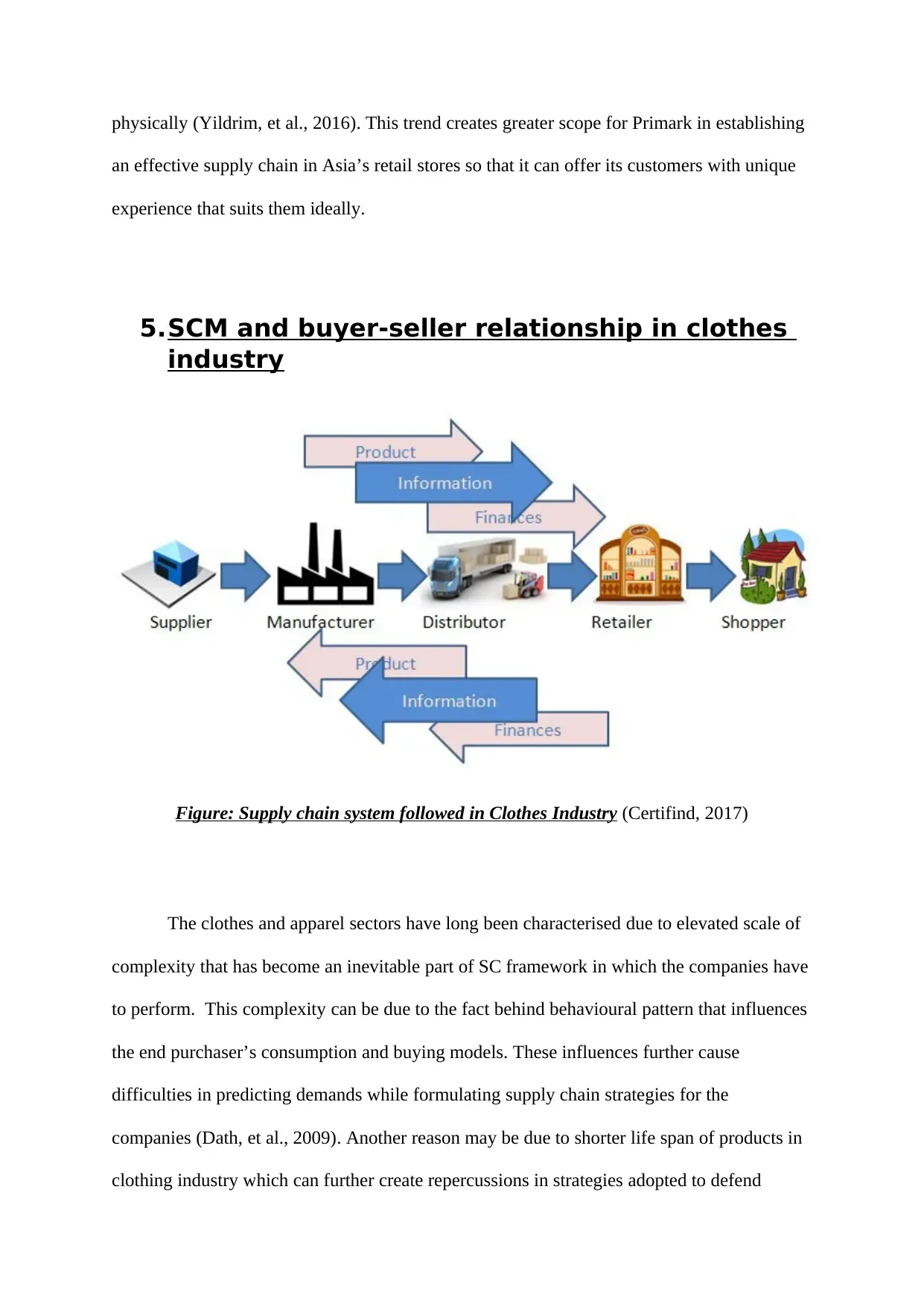
an effective supply chain in Asia’s retail stores so that it can offer its customers with unique
experience that suits them ideally.
5.SCM and buyer-seller relationship in clothes
industry
Figure: Supply chain system followed in Clothes Industry (Certifind, 2017)
The clothes and apparel sectors have long been characterised due to elevated scale of
complexity that has become an inevitable part of SC framework in which the companies have
to perform. This complexity can be due to the fact behind behavioural pattern that influences
the end purchaser’s consumption and buying models. These influences further cause
difficulties in predicting demands while formulating supply chain strategies for the
companies (Dath, et al., 2009). Another reason may be due to shorter life span of products in
clothing industry which can further create repercussions in strategies adopted to defend
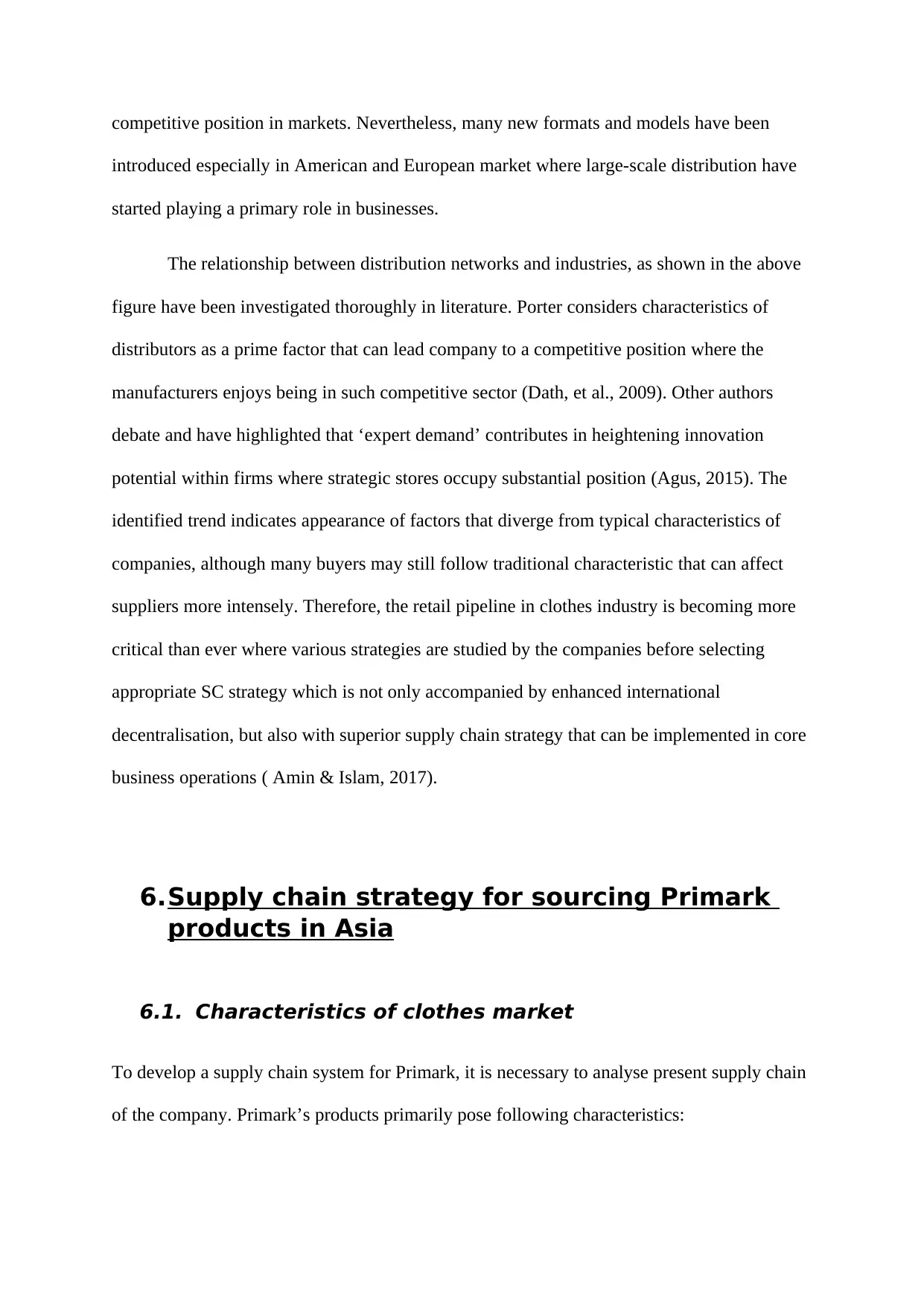
introduced especially in American and European market where large-scale distribution have
started playing a primary role in businesses.
The relationship between distribution networks and industries, as shown in the above
figure have been investigated thoroughly in literature. Porter considers characteristics of
distributors as a prime factor that can lead company to a competitive position where the
manufacturers enjoys being in such competitive sector (Dath, et al., 2009). Other authors
debate and have highlighted that ‘expert demand’ contributes in heightening innovation
potential within firms where strategic stores occupy substantial position (Agus, 2015). The
identified trend indicates appearance of factors that diverge from typical characteristics of
companies, although many buyers may still follow traditional characteristic that can affect
suppliers more intensely. Therefore, the retail pipeline in clothes industry is becoming more
critical than ever where various strategies are studied by the companies before selecting
appropriate SC strategy which is not only accompanied by enhanced international
decentralisation, but also with superior supply chain strategy that can be implemented in core
business operations ( Amin & Islam, 2017).
6.Supply chain strategy for sourcing Primark
products in Asia
6.1. Characteristics of clothes market
To develop a supply chain system for Primark, it is necessary to analyse present supply chain
of the company. Primark’s products primarily pose following characteristics:
⊘ This is a preview!⊘
Do you want full access?
Subscribe today to unlock all pages.

Trusted by 1+ million students worldwide
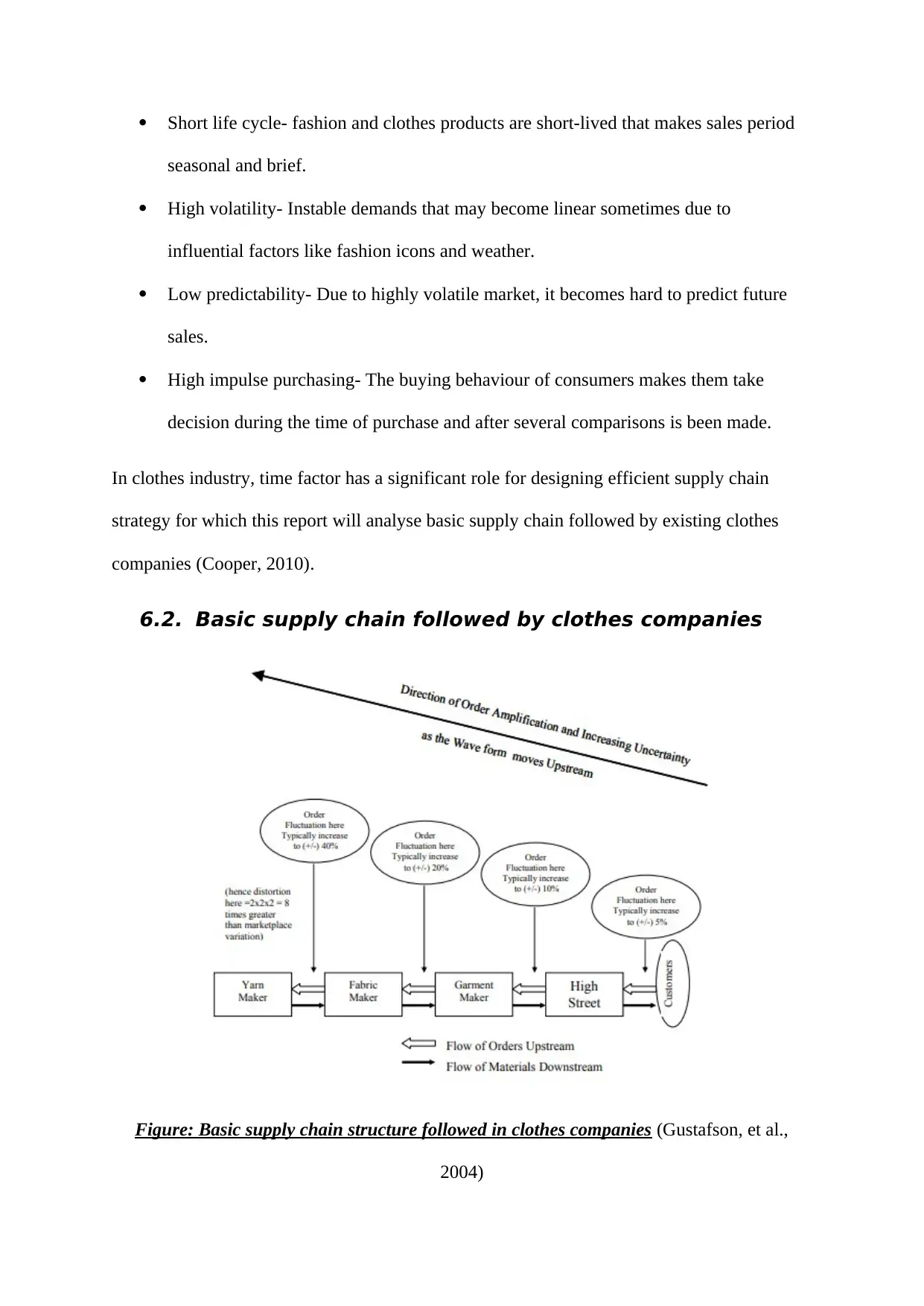
seasonal and brief.
High volatility- Instable demands that may become linear sometimes due to
influential factors like fashion icons and weather.
Low predictability- Due to highly volatile market, it becomes hard to predict future
sales.
High impulse purchasing- The buying behaviour of consumers makes them take
decision during the time of purchase and after several comparisons is been made.
In clothes industry, time factor has a significant role for designing efficient supply chain
strategy for which this report will analyse basic supply chain followed by existing clothes
companies (Cooper, 2010).
6.2. Basic supply chain followed by clothes companies
Figure: Basic supply chain structure followed in clothes companies (Gustafson, et al.,
2004)
Paraphrase This Document
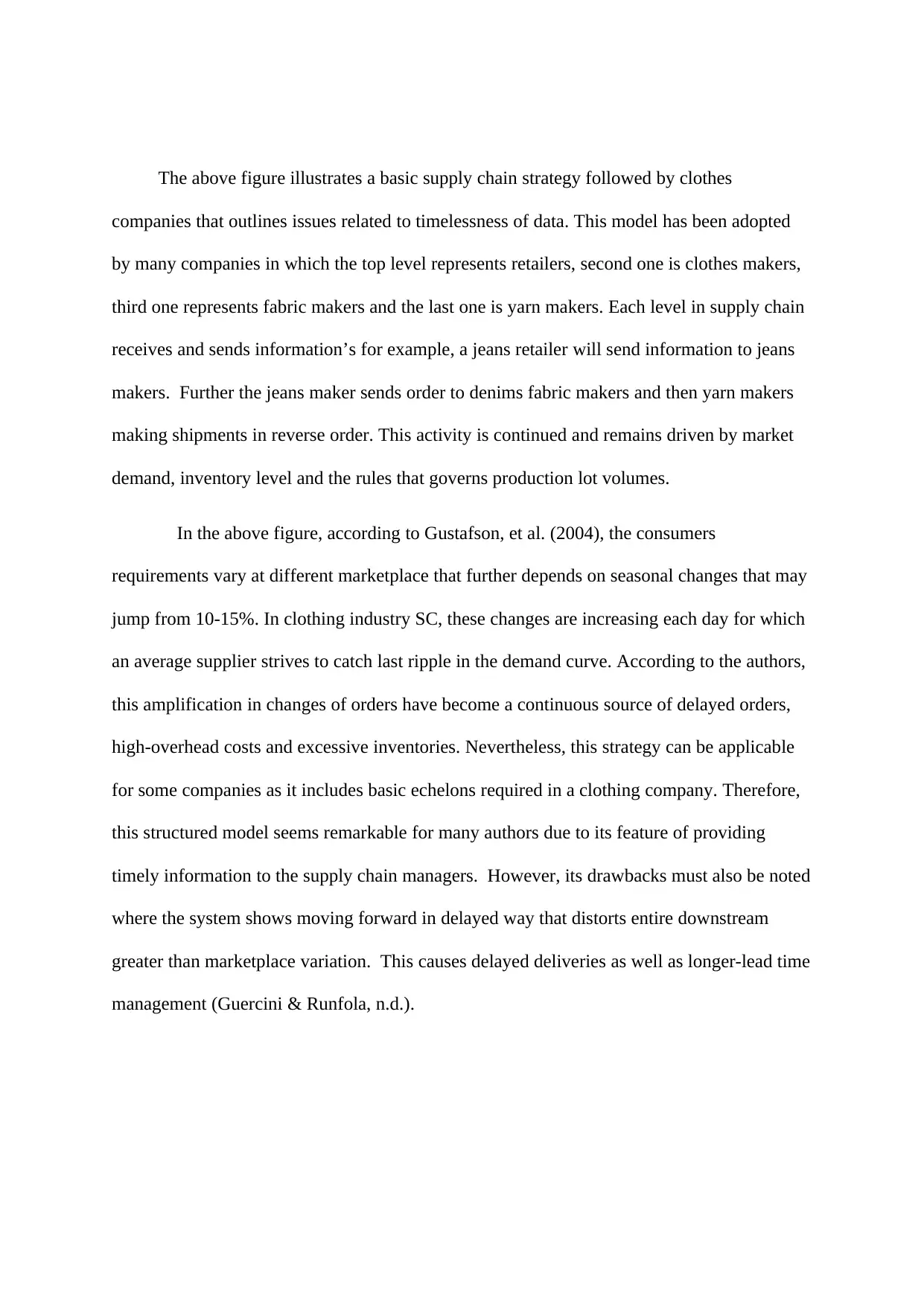
companies that outlines issues related to timelessness of data. This model has been adopted
by many companies in which the top level represents retailers, second one is clothes makers,
third one represents fabric makers and the last one is yarn makers. Each level in supply chain
receives and sends information’s for example, a jeans retailer will send information to jeans
makers. Further the jeans maker sends order to denims fabric makers and then yarn makers
making shipments in reverse order. This activity is continued and remains driven by market
demand, inventory level and the rules that governs production lot volumes.
In the above figure, according to Gustafson, et al. (2004), the consumers
requirements vary at different marketplace that further depends on seasonal changes that may
jump from 10-15%. In clothing industry SC, these changes are increasing each day for which
an average supplier strives to catch last ripple in the demand curve. According to the authors,
this amplification in changes of orders have become a continuous source of delayed orders,
high-overhead costs and excessive inventories. Nevertheless, this strategy can be applicable
for some companies as it includes basic echelons required in a clothing company. Therefore,
this structured model seems remarkable for many authors due to its feature of providing
timely information to the supply chain managers. However, its drawbacks must also be noted
where the system shows moving forward in delayed way that distorts entire downstream
greater than marketplace variation. This causes delayed deliveries as well as longer-lead time
management (Guercini & Runfola, n.d.).

Clothes industry being very agile in nature, Agile supply chain framework will be best
suited for Primark clothes company to source its products in Asian retail stores. One of the
major performance enhancement tools for agility is building partnerships with companies
supply chain and retail owners that can be further based upon factors like not letting
partnerships go beyond traditional buyer-customer interaction or forming a longer period
collaboration where partnership is established at strategic level amongst partners. Baramichai,
et al. (2007) states that a clothes company supply chain structure must be extremely dynamic
for which the company needs forming a chain which can be rotated and re-linked as
demanded in prompt manner to bring together available resources within contacts and dismiss
relationships after achieving particular objectives. Therefore, it can be asserted that agile
supply chain strategy can be developed and implemented in Primark’s core operations that
can establish long-term collaborative partnerships with agile suppliers’ group as well as
retailers where the company plans to source its products. This strategy will not only cope
with unpredictable market demands, but also develop relationship with Asia’s clothes
retailers in quick and efficient way.
⊘ This is a preview!⊘
Do you want full access?
Subscribe today to unlock all pages.

Trusted by 1+ million students worldwide

As shown in the above figure, the first characteristic of ASC is market sensitive that
means that SC is able to comprehend and respond to actual demands. Many companies
possess features like forecasting instead of demand driven feature that makes them forecast
on the basis of previous sales and shipments for determining their inventory in that manner.
Since efficient consumers response and IT have developed increasingly in past few decades,
companies are able to collect data in more efficient way by measuring demands directly from
point of sale (POS). This exchange of data between suppliers and retailers through IT creates
virtual supply chain that is more based on information’s rather than inventory based. The
visibility of demand makes logistics more conventional through exchange of critical
information’s (Gustafson, et al., 2004). Similarly, partners are able to act upon the same
information and share them with their supply chain partners to get advantage in process
integration. Hence, cooperation formed between suppliers and buyers enables process
integration more efficiently where companies can then focus on their core competencies
along with outsourcing other activities. The fourth characteristic that makes SC agile is
network through which partners get linked together. Since individual business does not need
competing against each other’s, it is SC that competes (Marcus, 2010).
Paraphrase This Document
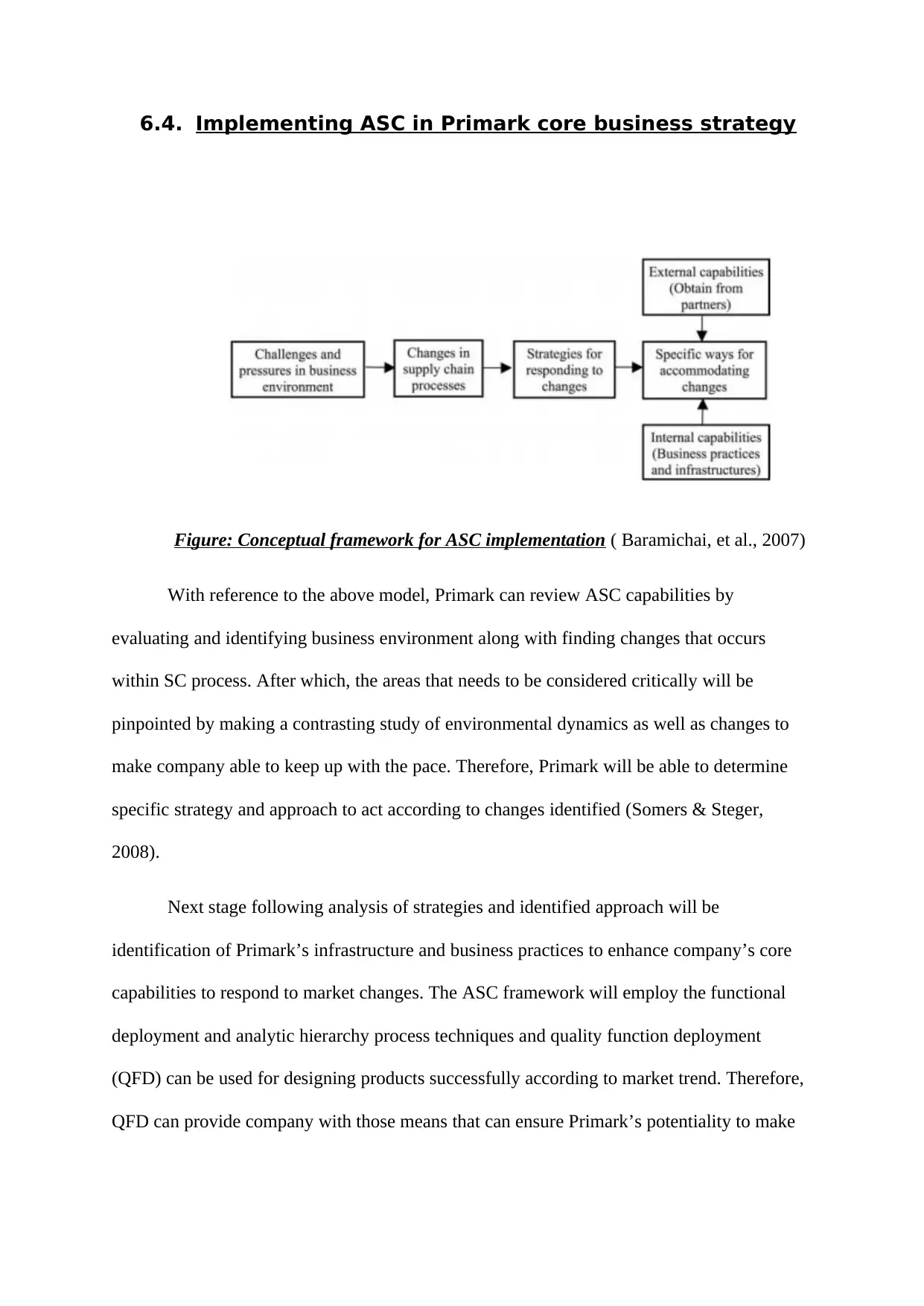
Figure: Conceptual framework for ASC implementation ( Baramichai, et al., 2007)
With reference to the above model, Primark can review ASC capabilities by
evaluating and identifying business environment along with finding changes that occurs
within SC process. After which, the areas that needs to be considered critically will be
pinpointed by making a contrasting study of environmental dynamics as well as changes to
make company able to keep up with the pace. Therefore, Primark will be able to determine
specific strategy and approach to act according to changes identified (Somers & Steger,
2008).
Next stage following analysis of strategies and identified approach will be
identification of Primark’s infrastructure and business practices to enhance company’s core
capabilities to respond to market changes. The ASC framework will employ the functional
deployment and analytic hierarchy process techniques and quality function deployment
(QFD) can be used for designing products successfully according to market trend. Therefore,
QFD can provide company with those means that can ensure Primark’s potentiality to make

2005).
Figure: AGC analysis ( Baramichai, et al., 2007)
Additionally, by employing ASC approach, prioritising the significant potential
changes and appropriateness in change can be improved in clear fashion by following
different phases of ASC tool. Based on the above figure readings and information gained
from ASC strategy adopted by contemporary organisations, Primark needs to reposition its
purchase and supply strategies for retailing its products in more adaptable way. Supply chain
strategy of the company must be based on quality, cost and flexibility in purchasing for
making quantity adjustments ( Baramichai, et al., 2007). Being a supply chain manager of the
company, few recommendations can further be made for Primark while implementing agility
in its supply chain strategies.
⊘ This is a preview!⊘
Do you want full access?
Subscribe today to unlock all pages.

Trusted by 1+ million students worldwide
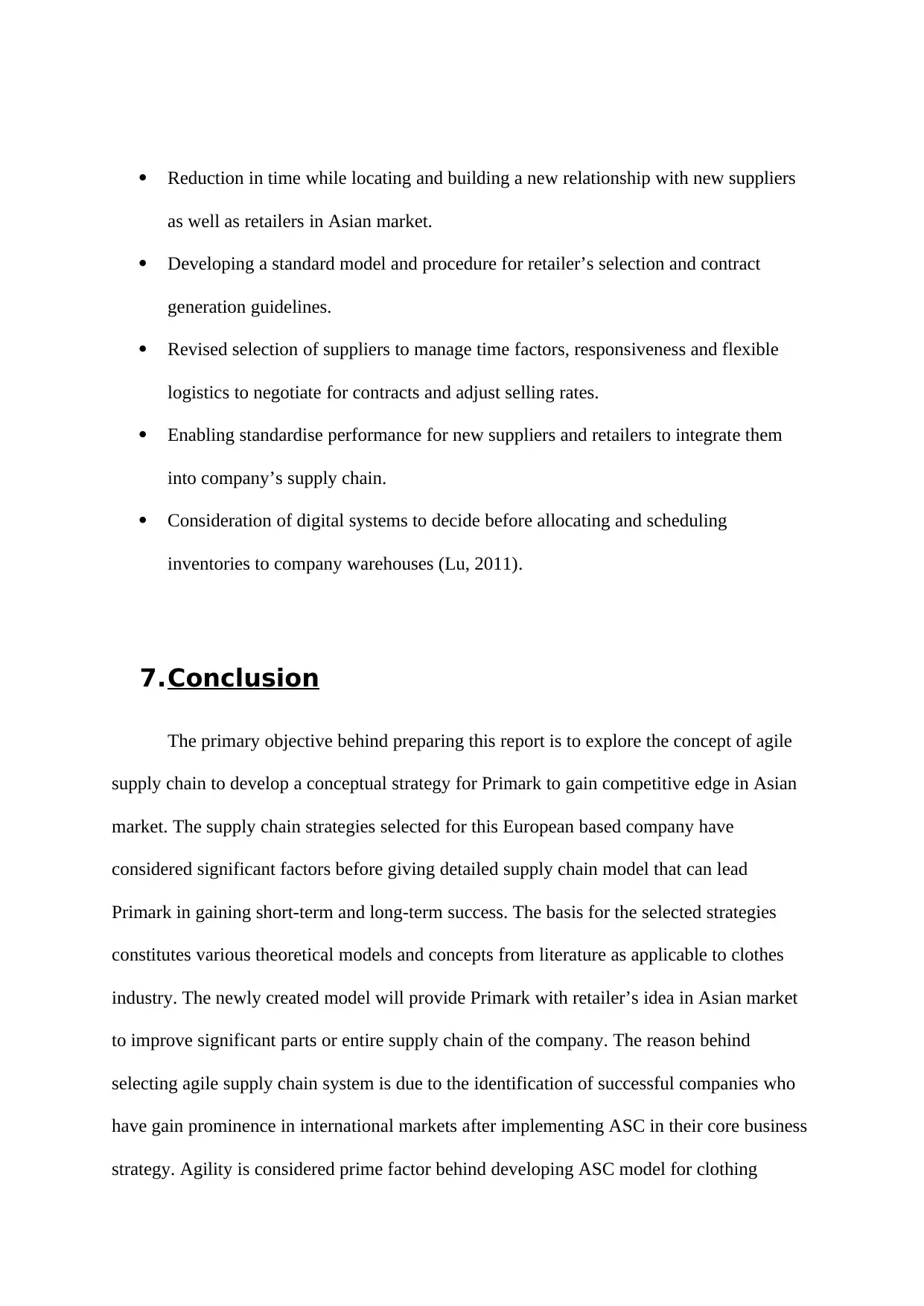
as well as retailers in Asian market.
Developing a standard model and procedure for retailer’s selection and contract
generation guidelines.
Revised selection of suppliers to manage time factors, responsiveness and flexible
logistics to negotiate for contracts and adjust selling rates.
Enabling standardise performance for new suppliers and retailers to integrate them
into company’s supply chain.
Consideration of digital systems to decide before allocating and scheduling
inventories to company warehouses (Lu, 2011).
7.Conclusion
The primary objective behind preparing this report is to explore the concept of agile
supply chain to develop a conceptual strategy for Primark to gain competitive edge in Asian
market. The supply chain strategies selected for this European based company have
considered significant factors before giving detailed supply chain model that can lead
Primark in gaining short-term and long-term success. The basis for the selected strategies
constitutes various theoretical models and concepts from literature as applicable to clothes
industry. The newly created model will provide Primark with retailer’s idea in Asian market
to improve significant parts or entire supply chain of the company. The reason behind
selecting agile supply chain system is due to the identification of successful companies who
have gain prominence in international markets after implementing ASC in their core business
strategy. Agility is considered prime factor behind developing ASC model for clothing
Paraphrase This Document

analysis for the success Primark. Differentiation strategy is also applicable to ASC strategy
that will further help Primark in meeting overall objective behind entering into Asian market.
Therefore, agile supply chain strategy is been explored and developed according to Primark’s
needs in the above report that will assist the company in sourcing its products to retailers
situated in Asian countries.
References

Performance and Product Quality. Journal of Economics, Business and Management, 03(11),
pp. 1046-1053.
Amin, M. A. & Islam, M. . S., 2017. Factors leading to Market Segmentation of fashion
house business based on customer behavior: Evidence from Bangladeshi Fashion Industry.
International Journal of Business and Technopreneurship, 07(03), pp. 251-272.
Anon., 2017. Agile supply chain management. [Online]
Available at: https://conspecte.com/Supply-Chain-Management/agile-supply-chain-
management.html
[Accessed 11 10 2018].
Baramichai, M., Jr , E. . W. Z. & Marangos, C. . A., 2007. Agile supply chain transformation
matrix: an integrated tool for creating an agile enterprise. Supply Chain Management: An
International Journal, 12(05), pp. 334-348.
BusinessGreen, 2018. Primark publishes Global Sourcing Map in ethical supply chain push.
[Online]
Available at: https://www.businessgreen.com/bg/news/3026351/primark-publishes-global-
sourcing-map-in-ethical-supply-chain-push
[Accessed 11 10 2018].
Certifind, 2017. How to Improve Business Activities with an Efficient Supply Chain
Management Process?. [Online]
Available at: http://certifind.com/blog/improve-business-activities-with-an-efficient-supply-
chain-management-process-and-courses-in-uae/
[Accessed 11 10 2018].
⊘ This is a preview!⊘
Do you want full access?
Subscribe today to unlock all pages.

Trusted by 1+ million students worldwide

Textile and Apparel, Technology and Management, 06(04), pp. 1-10.
Dath, S., Rajendran, C. & Narashiman, K., 2009. A conceptual framework for Supply Chain
Management with specific reference to a developing economy. Int. J. Logistics Systems and
Management, 05(05), pp. 473-524.
Guercini, S. & Runfola, A., n.d. Sourcing strategies in clothing retail firms: product
complexity versus overseas supply chain. [Online]
Available at: https://www.impgroup.org/uploads/papers/4548.pdf
[Accessed 11 10 2018].
Gustafson, A., Schmiesing-Korff, A. V. & Ng, S. L., 2004. Time Efficient Supply Chain
Model For an Apparel Company. [Online]
Available at: http://www.diva-portal.org/smash/get/diva2:229585/fulltext01.pdf
[Accessed 11 10 2018].
Jain, J., Dangayach, G. . S., Agarwal, G. & Banerjee, S., 2010. Supply Chain Management:
Literature Review and Some Issues. Journal of Studies on Manufacturing, 01(01), pp. 11-25.
Kawazo, N., 2013. Consumer Trends and Expansion of Retail Markets in Growing ASEAN
Economies. [Online]
Available at: https://www.nri.com/global/opinion/papers/2013/pdf/np2013182.pdf
[Accessed 10 10 2018].
Kumar, S., 2005. Supply Chain Strategies in the Apparel Industry: The Case of Victoria’s
Secret. [Online]
Available at: https://courses.edx.org/asset-
v1:MITx+CTL.SC2x+3T2015+type@asset+block/theses_2005_Kumar_Thesis.pdf
[Accessed 11 10 2018].
Paraphrase This Document

Mahmood, S., Vehkaperä , H. . K. & Kess , P., 2017. A Comparative Study of the Supply
Chain Key Factors Differentiated by Nearshore Manufacturing. Venice, Management
International Conference.
Marcus, I., 2010. Agile Supply Chain: Strategy for Competetive Advantage. Journal of
Global Strategic Management , 04(01), pp. 5-17.
McKinsey & Company , 2018. The State of Fashion 2018. [Online]
Available at: https://cdn.businessoffashion.com/reports/The_State_of_Fashion_2018_v2.pdf
[Accessed 10 10 2017].
Primark, 2010. Primark: Logistics & Supply Chain. [Online]
Available at: https://www.logisticsandsupplychain.com/3279-primark/
[Accessed 11 10 2018].
Somers , A. . I. & Steger, . U., 2008. Business Logic for Sustainability. Hampshire:
PALGRAVE MACMILLAN.
Verma , A. & Seth, N., 2011. A Conceptual Framework for Supply Chain Competitiveness.
International Journal of Human and Social Sciences, 06(01), pp. 5-10.
Yildrim, S., Aydin, K. & Ustaahmetoglu, E., 2016. Segmentation of Female Apparel Market
Through Consumer Decision Making Style. Balkan Journal of Social Sciences, 05(09), pp.
115-130.
Related Documents
Your All-in-One AI-Powered Toolkit for Academic Success.
+13062052269
info@desklib.com
Available 24*7 on WhatsApp / Email
![[object Object]](/_next/static/media/star-bottom.7253800d.svg)
© 2024 | Zucol Services PVT LTD | All rights reserved.





